enrollment
5 Graduate and Online Enrollment Trends to Watch in 2024
One of my colleagues asked me to plan a session for an upcoming conference called “Empowering Excellence: Trends Driving Innovation and Change in 2024.” As I sifted through all the data released last fall by IPEDS, National Student Clearinghouse, Open Doors, Council of Graduate Schools, and more, I arrived at five data-driven trends that institutions will likely have to take into account as they chart their course in 2024. This is not an exhaustive list, but a snapshot of the many areas in which change is occurring.
Traditional undergraduate challenges remain
National Student Clearinghouse 2023 fall enrollment data indicate that undergraduate enrollment grew for the first time in several years (+1.2%), but this incremental growth was driven by community colleges (+2.6%) and privates (+1.0%). First year enrollment was also up by contracted (+.8%).
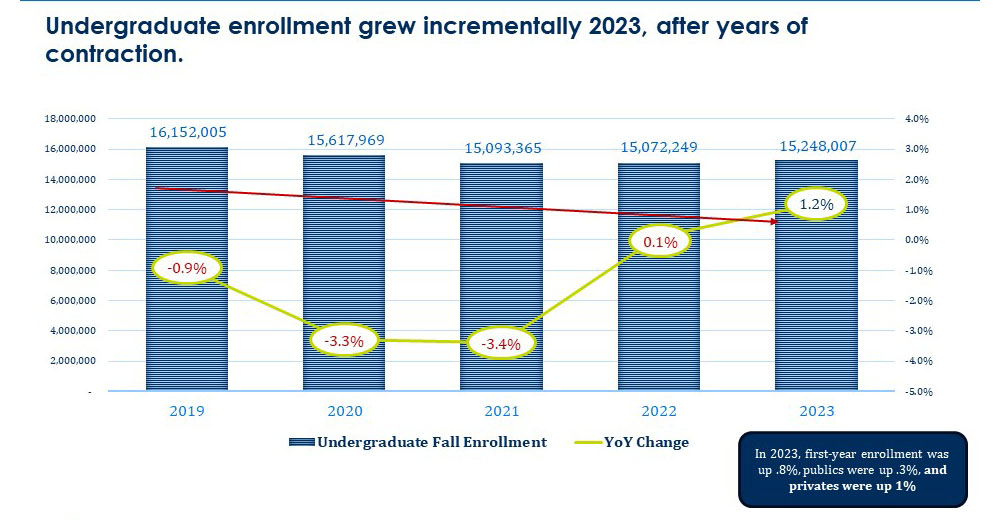
Implications for 2024: Institutions must continue to bring alternative student populations (graduate, online, and adult undergraduate) from the periphery to the center in order to diversify their revenue streams. As these alternative populations become critical to institutional health, marketing, recruitment, admission, and other functions that drive enrollment growth must also move from being decentralized in schools and programs to being centralized so that institutional leadership can set and meet goals. Simultaneously, institutions must ensure that their marketing, recruitment, and admissions processes align with traditional undergraduate expectations and are sophisticated and savvy as their strongest competitors.
Online is already leading graduate degree production
My own analysis of 2023 calendar year IPEDs degree production data indicate that master’s degree conferrals among programs available online (495,0227) exceeded conferrals in classroom-only programs (396,843) by nearly 100,000. This trend is in its second consecutive year, with online-available having exceeding classroom-only by about 60,000 in 2022.
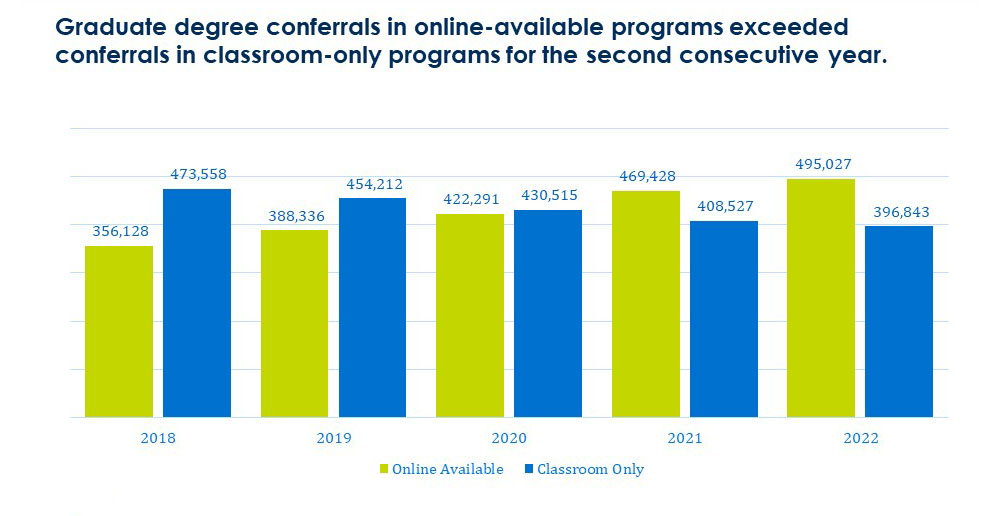
Implications for 2024: As institutions think through their enrollment growth plans, graduate programs have become essential to the conversation. In most cases, institutions should not rely on classroom-only master’s programs as areas of growth. If you have a program that you think is essential to your growth strategy, you must ensure that students can complete it online (perhaps in addition to your classroom version.) Institutions should also review their existing programs and carefully evaluate whether they are achieving their enrollment potential before contemplating new programs. Why? Because few institutions have three to five years for programs to materially contribute to enrollment growth.
Talk with our graduate and online enrollment experts
Ask for a free consultation with us. We’ll help you assess your market and develop the optimal strategies for your prospective graduate students and online learners.
Current efforts to differentiate may be backfiring
IPEDS data indicate that the number of available degree subjects has skyrocketed, with more than 1,000 distinct categories reporting degrees in 2022. But the 10 largest bachelor’s and master’s degree subjects accounted for more than 30 percent of all degrees produced. This leaves more than 900 other degree areas to compete for the balance of students, and there are more than 800 degree areas producing fewer than 500 degrees across the nation.
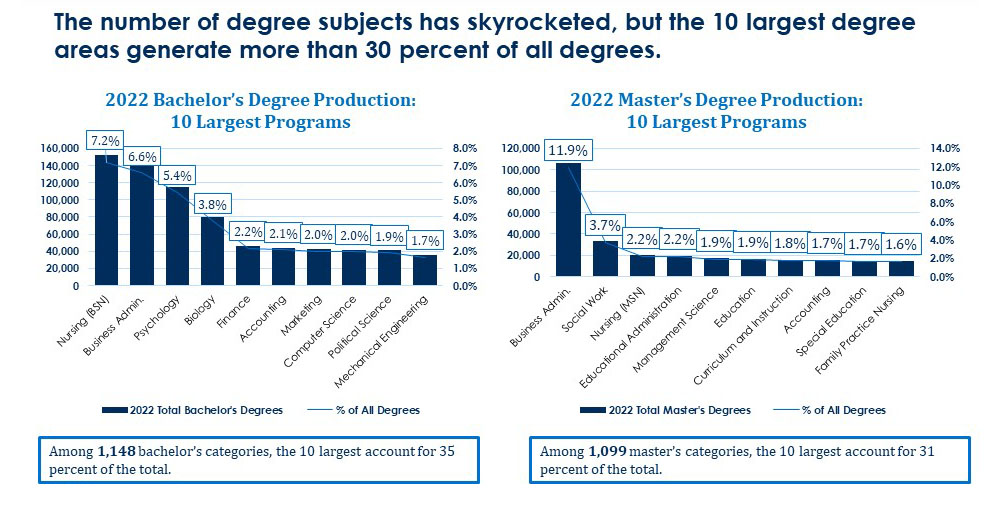
Implications for 2024: The explosion of available degree subjects has been driven by institutions seeking to offer programs that are clearly differentiated from competitor offerings and therefore not require them to actively compete with all other available offerings. However, students indicate that while they seek programs that match their interests, they still search for “social work” or “human resources” or “accounting” when looking for a program. While they may have specific areas of interest, at the end of the day their career prospects are best in broader rather than more specific programming. Institutions should seek to differentiate their offerings in ways that offer flexibility in making a program their own: electives, concentrations, optional internships, etc. These will both widen the appeal of the program and offer the customization/personalization that today’s student experience elsewhere in their lives.
Multiple start (online) programs get the students
PhilOnEdTech reported for the second time that in 2021 more than 800,000 graduate students and 5.1 million undergraduate students first enrolled at times other than the traditional fall semester. My own analysis of these data made clear that all of the graduate students and all but 200,000 undergrads enrolled in either fully online or hybrid study.
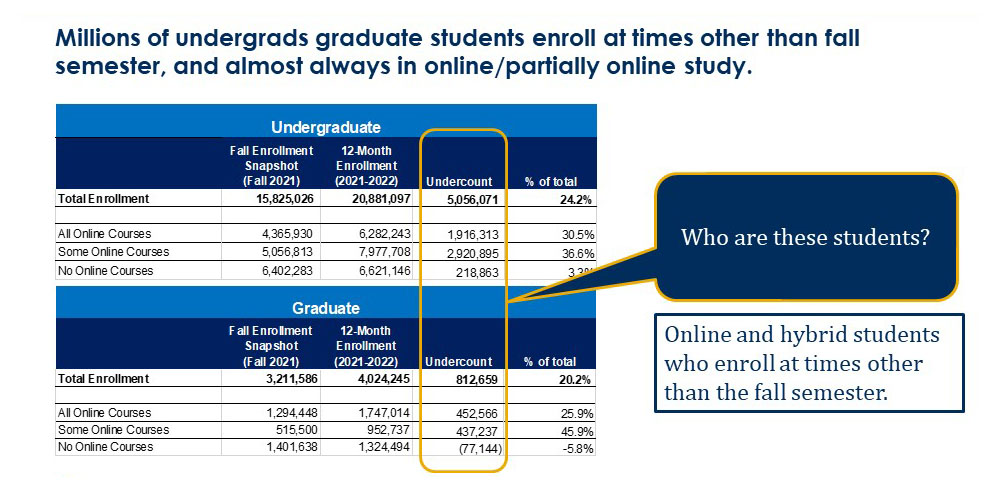
Implications for 2024: As competition becomes even more strenuous than in previous years, institutions should be looking for any area of opportunity. If you have programs that only admit new students once a year, consider three things:
- Ensure you have an online or partially online version of the program.
- Enable students to enroll at a minimum of three times (each of your semesters and your summer term).
- Break your semesters into two terms and admit at each term. This recommendation is based on 2023 RNL data that found less than one-quarter of either online or graduate students enroll in programs with semester-length courses. Making this change should bring your entry points to no fewer than six. The added advantage of this change is that in this ever-more impatient world, no prospective student should have to wait more than about eight weeks to enroll in your program.
International enrollment growth may be temporary
The 2023 Institute for International Education (IIE) Open Doors report indicates that the international student enrollment increased 12 percent in 2022-23, which nearly wipes out pandemic era contraction. China, distantly followed by India provided the greatest numbers of students, and these students comprise about 10 percent of all graduate students and about 2 percent of all undergrads.
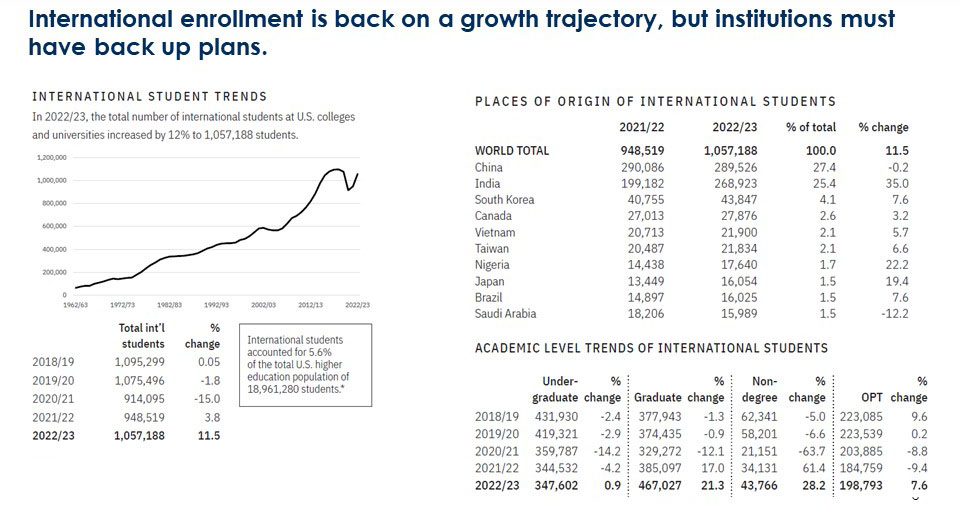
Implications for 2024: Many institutions will see this as a return to “normal”, alleviating some of the pressure of having to replace missing international students with domestic students. However, there are a myriad of both geopolitical and environmental circumstances that may present themselves in the coming years that may again destabilize international enrollment. With this in mind, I recently conducted market research for a graduate school where, prior to the pandemic, 80 percent of its students were international. The focus of the research was on the demands and preference of the domestic audience. The goal was to future-proof the institution by understand more precisely what they need to do to make themselves attractive to domestic students.
How can we help you stay ahead of win in today’s graduate and online markets?
RNL enrollment consultants are ready to help you navigate a path through all the challenges that these and other trends may raise. To that end, we have created a new “How to Win in the Graduate and Online Markets” presentation that we’d be happy to share with you. Reach out for a complimentary consultation and we will set up a time to present our strategies.
